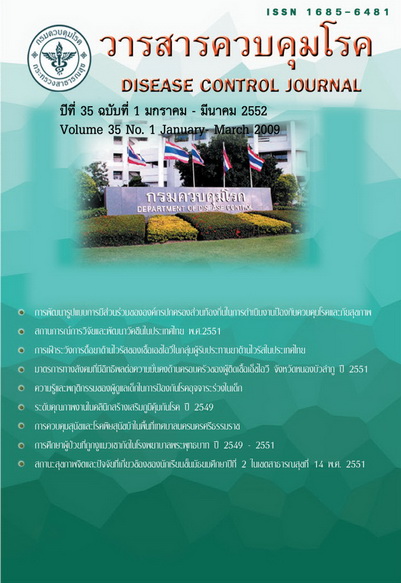Surveillance of HIV-1 Antiretroviral Drug Resistant Strains in Thailand
Keywords:
Surveillance, drug resistance, Antiretroviral drugsAbstract
In this study, surveillance of HIV-1 drug resistance was conducted on 307 AIDS/HIV infected patients who received ART for more than 6 months from 14 provinces in all parts of Thailand. Most of the patients were treated with GPO-VIR (67.7%), other NRTIs+NNRTIs regimens (23.1%) and only 7.2% of patients were treated with PIs regimens. All plasma samples of 307 patients were assessed for viral load level and 37 patients had viral load > 1,000 copies/ml that were further analyzed for HIV drug resistance by genotyping assay. The highest frequency of NRTI drug resistant mutation was M184V (97.1%) that associated with resistance to 3TC in 34 patients. Thymidine analogue-associated mutations (TAMs) were M41L (22.8%), D67N (34.3%), K70R (14.3%), L210W (11.4%), T215F (31.4%), K219R (20.0%). Mutations that associated with NNRTI drug resistance were A98G (14.3%), K101E (22.8%), K103N (34.3%), V108I (22.8%), Y181C (42.8%), Y188L (5.7%), G190S (34.3%) and P225H (8.6%). Resistance to NVP and EFV were found in 34 and 20 patients respectively. PIs-associated mutations were found in all 37 patients but only one patient was resistant to PIs. In conclusion, the percentage of ARV drug resistance were 11.4% (35/307) in all treated patients, 14.5% (18/124) in patients treated for > 3 years and 13.3% (8/60) in patients treated for >1-2 years.
Downloads
References
2. สำนักโรคเอดส์ วัณโรค และโรคติดต่อทางเพศสัมพันธ์. แนวทางการดูแลรักษาผู้ติดเชื้อเอชไอวีและผู้ป่วยโรคเอดส์ เด็กและผู้ใหญ่ในประเทศไทยปี พ.ศ.2545. กรมควบคุมโรค กระทรวงสาธารณสุข.
3. Cohen J. Thailand do-it-yourself therapy. Science 2003; 301:1662.
4. Schechter M, Suely Hiromi Tuboi SH. Discordant immunological and virological responses to antiretroviral therapy. J Antimicrob Chemother 2006; 58, 506-510.
5. Sutthent R, Arworn D, Surapol Kaoriangudom S, et al. HIV-1 drug resistance in Thailand: Before and after National Access to Antiretroviral Program. J Clin Virol 2005; 34, 272-276.
6. วสันต์ จันทราทิตย์. บทที่ 3 การระบาดของเชื้อเอชไอวี และการติดตามอุบัติการณ์การเกิดเชื้อดื้อยาต้านไวรัสในประเทศไทย ด้วยเทคนิคอณูชีววิทยาและชีวสารสนเทศ. ในการเพิ่มประสิทธิภาพการรักษาผู้ติดเชื้อเอชไอวีด้วยเทคโนโลยีอณูชีววิทยา ชีวสารสนเทศและเภสัชพันธุศาสตร์. บริษัท กราฟฟิคฮัท จำกัด 2550
Downloads
Published
How to Cite
Issue
Section
License
Articles published in the Disease Control Journal are considered as academic work, research or analysis of the personal opinion of the authors, not the opinion of the Thailand Department of Disease Control or editorial team. The authors must be responsible for their articles.






